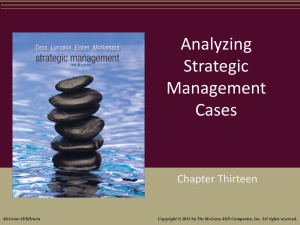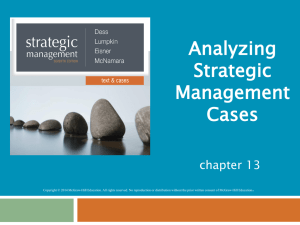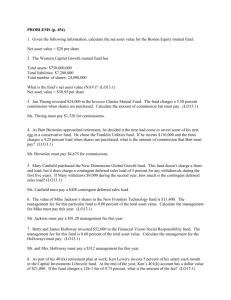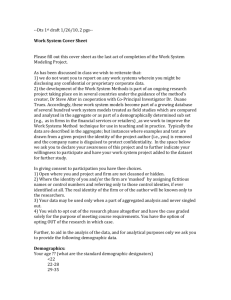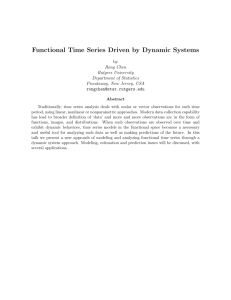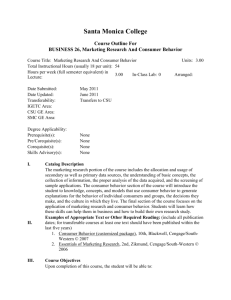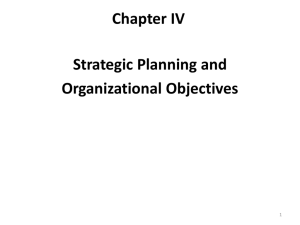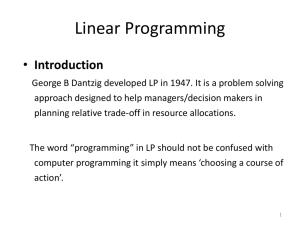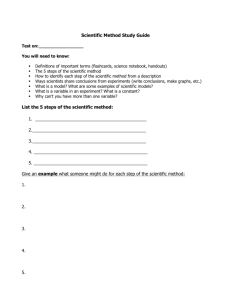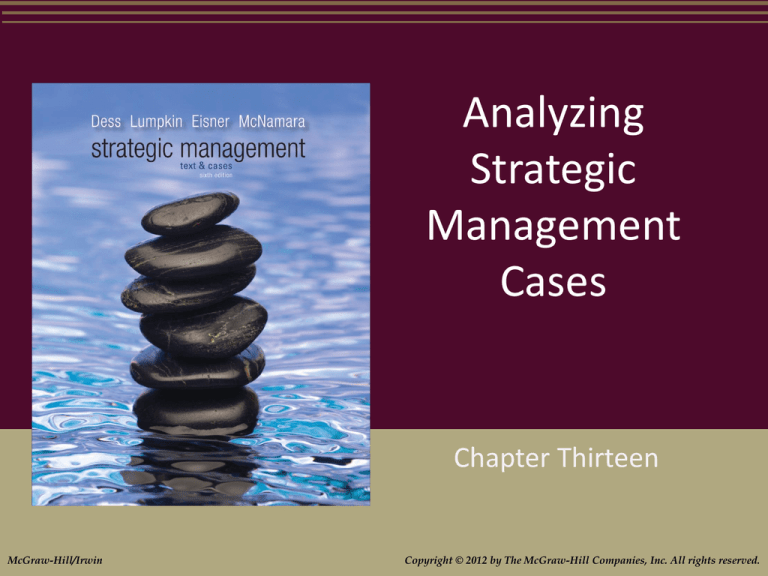
Analyzing
Strategic
Management
Cases
Chapter Thirteen
McGraw-Hill/Irwin
Copyright © 2012 by The McGraw-Hill Companies, Inc. All rights reserved.
Learning Objectives
After reading this chapter, you should have a
good understanding of:
LO13.1 How strategic case analysis is used to
simulate real-world experiences.
LO13.2 How analyzing strategic management cases
can help develop the ability to differentiate,
speculate, and integrate when evaluating
complex business problems.
LO13.3 The steps involved in conducting a strategic
management case analysis.
13-2
Learning Objectives (cont.)
LO13.4 How to get the most out of case analysis.
LO13.5 How conflict-inducing discussion
techniques can lead to better decisions.
LO13.6 How to use the strategic insights and
material from each of the 12 previous
chapters in the text to analyze issues posed
by strategic management cases.
13-3
Questions Raised
Why do some firms succeed and others fail?
Why are some companies higher performers
than others?
What information is needed in the strategic
planning process?
How do competing values and beliefs affect
strategic decision making?
What skills and capabilities are needed to
implement a strategy effectively?
13-4
Why Analyze Strategic
Management Cases?
Case analysis
A method of learning complex strategic
management concepts
places students in the middle of an
actual situation and challenges them to
figure out what
to do.
13-5
Skills Developed from Case Analysis
Differentiate
Evaluate many different elements of a
situation at once
Differentiating between the factors that
are influencing the situation
Understanding that problems are often
complex and multilayered
13-6
Skills Developed from Case Analysis
Speculate
Envision explanation that might not
readily be apparent
Imagine different scenarios
Contemplate the outcome of a decision
Deal with uncertainty and incomplete
knowledge
13-7
Skills Developed from Case Analysis
Integrate
Have an organization-wide perspective
Integrate the impact of various
decisions and environmental influences
on all parts of the organization
13-8
How to Conduct a Case Analysis
Prepare for a case discussion
Investigate
Analyze and research potential
solutions
Gather the advice of others
Become immersed in facts, options,
and implications
13-9
How to Conduct a Case Analysis
Put yourself
“inside” the case
Think like an actual
participant
Try different
perspectives
13-10
Positions to Take
Strategic
Decision
Maker
Outside
Consultants
Board of
Directors
13-11
How to Conduct a Case Analysis
Step 1: Become familiar with the material
Read quickly through the case one time
Use initial read-through to assess
possible links to strategic concepts
Read the case again, making notes
13-12
How to Conduct a Case Analysis
Step 1: Become familiar with the material
Evaluate how strategic concepts might
inform key decisions or suggest
alternative solutions.
After forming first recommendation,
thumb through the case again to
assess consequences of actions you
propose
13-13
How to Conduct a Case Analysis
Step 2: Identify problems
Some cases have more than one
problem
Avoid getting hung up on symptoms
Articulate the problem
Some problems are not apparent until
after you do the analysis
13-14
How to Conduct a Case Analysis
Step 3: Conduct strategic analyses
Determine which strategic issues are
involved
Use strategic tools to conduct the
analysis
Test your own assumptions about the
case
13-15
Tools to Conduct Analysis
Five forces
Contingency
analysis
Value-chain
analysis
frameworks
Financial ratio
analysis
13-16
Financial Ratio Analysis
Financial ratio analysis
Method of evaluating a company’s
performance and financial wellbeing
through ratios of accounting values,
including short-term solvency, longterm solvency, asset utilization,
profitability, and market value ratios.
13-17
How to Conduct a Case Analysis
Step 4: Propose
alternative solutions
Develop a list of
options first without
judging them
Evaluate
alternatives
13-18
How to Conduct a Case Analysis
Step 5: Make recommendations
Make a set of recommendations that
your analysis supports
Describe exactly what needs to be
done
Explain why this course of action will
solve the problem
Include suggestions for how best to
implement the proposed solution
13-19
Preparing an Oral Case Presentation
Organize your thoughts
Emphasize strategic analysis
Be logical and consistent
Defend your position
Share presentation responsibilities
13-20
Example
Here are five tips to “wow” your audience like
Steve Jobs, co-founder of Apple:
Sell the benefit
Practice, Practice, and Practice Some More
Keep It Visual
Exude Passion, Energy, and Enthusiasm
At the end of your presentation add more
suspense by stating “and one more thing..."
13-21
How to Get the Most from
Case Analysis
Keep an open mind
Take a stand for what you believe
Draw on your own personal experience
Participate and persuade
Be concise and to the point
13-22
How to Get the Most from
Case Analysis (cont.)
Think out of the box
Learn from the insights of others
Apply insights from other case analyses
Critically analyze your own performance
Conduct outside research
13-23
Preparing a Written Case Analysis
Exhibit 13.3
13-24
QUESTION
What are the symptoms of groupthink
identified by Irving Janis? Have you
experienced any of these in a group
situation? Explain.
13-25
Using Conflict to Improve
Decision Making
Devil’s advocacy
a method of
introducing conflict
into a decisionmaking process by
having specific
individuals or
groups act as a
critic to an analysis
or planned solution.
13-26
Using Conflict to Improve
Decision Making
Dialectical inquiry
a method of introducing conflict into a
decision-making process by devising
different proposals that are feasible,
politically viable, and credible, but rely
on different assumptions; and debating
the merits of each.
13-27
Following the Analysis-DecisionAction Cycle in Case Analysis
1. Analyzing organizational goals and
objectives
Has the company developed short-term
objectives that are inconsistent with its longterm mission?
Has the company considered all of its
stakeholders equally in making critical
decisions?
13-28
Following the Analysis-DecisionAction Cycle in Case Analysis
2. Analyzing the external environment
Does the company follow trends and events
in external environment?
Is the company effectively scanning and
monitoring the competitive environment?
Has the company analyzed the impact of
competitive forces in its industry on
profitability?
13-29
Following the Analysis-DecisionAction Cycle in Case Analysis
3. Analyzing the internal environment
Does the company know how the various
components of its value chain are adding
value to the firm?
Is the company’s financial performance as
good as or better than that of its close
competitors?
13-30
Following the Analysis-DecisionAction Cycle in Case Analysis
4. Assessing a firm’s intellectual assets
Does the company have underutilized
human capital?
Is the company missing opportunities to
forge strategic alliances?
Has the company developed knowledgemanagement systems that capture what it
learns?
13-31
Following the Analysis-DecisionAction Cycle in Case Analysis
5. Formulating business-level strategies
Has the company chosen the correct
competitive strategy, given its industry
environment and competitive situation?
Does the company use combination
strategies effectively?
13-32
Following the Analysis-DecisionAction Cycle in Case Analysis
6. Formulating corporate-level strategies
Is the company competing in the right
businesses, given the opportunities and
threats that are present in the environment?
Is the corporation managing its portfolio of
businesses in a way that creates synergies
among the businesses?
13-33
Question
Corporate strategies address methods for
achieving ______ among businesses within
a large firm’s portfolio.
A. Synergies
B. Competitiveness
C. Devil’s advocacy
D. Teamwork
13-34
Following the Analysis-DecisionAction Cycle in Case Analysis
7. Formulating international-level
strategies
Is the company’s entry into an international
marketplace threatened by the actions of
local competitors?
Has the company made the appropriate
choices between cost reduction and local
adaptation to foreign markets?
13-35
Following the Analysis-DecisionAction Cycle in Case Analysis
8. Formulating entrepreneurial strategies
Is the company engaged in an ongoing
process of opportunity recognition?
Do the entrepreneurs who are launching new
ventures have vision, dedication and drive,
and a commitment
to excellence?
13-36
Following the Analysis-DecisionAction Cycle in Case Analysis
9. Achieving effective strategic control
Is the company employing the appropriate
informational control systems?
Does the company have a strong and
effective culture?
Has the company implemented control
systems that match its strategies?
13-37
Following the Analysis-DecisionAction Cycle in Case Analysis
10. Creating effective organizational
designs
Has the company implemented
organizational structures that are suited to
the type of business it is in?
Is the company employing boundaryless
organizational designs where appropriate?
13-38
Following the Analysis-DecisionAction Cycle in Case Analysis
11.Creating a learning organization and
an ethical organization
Do company leaders promote excellence as
part of the overall culture?
Is the company committed to being a
learning organization?
Have company leaders exhibited an ethical
attitude in their own behavior?
13-39
Following the Analysis-DecisionAction Cycle in Case Analysis
12. Fostering corporate entrepreneurship
Has the company resolved the dilemmas
associated with managing innovation?
Has the company developed autonomous
work units that have the freedom to bring
forth new product ideas?
Does the company have an entrepreneurial
orientation?
13-40

